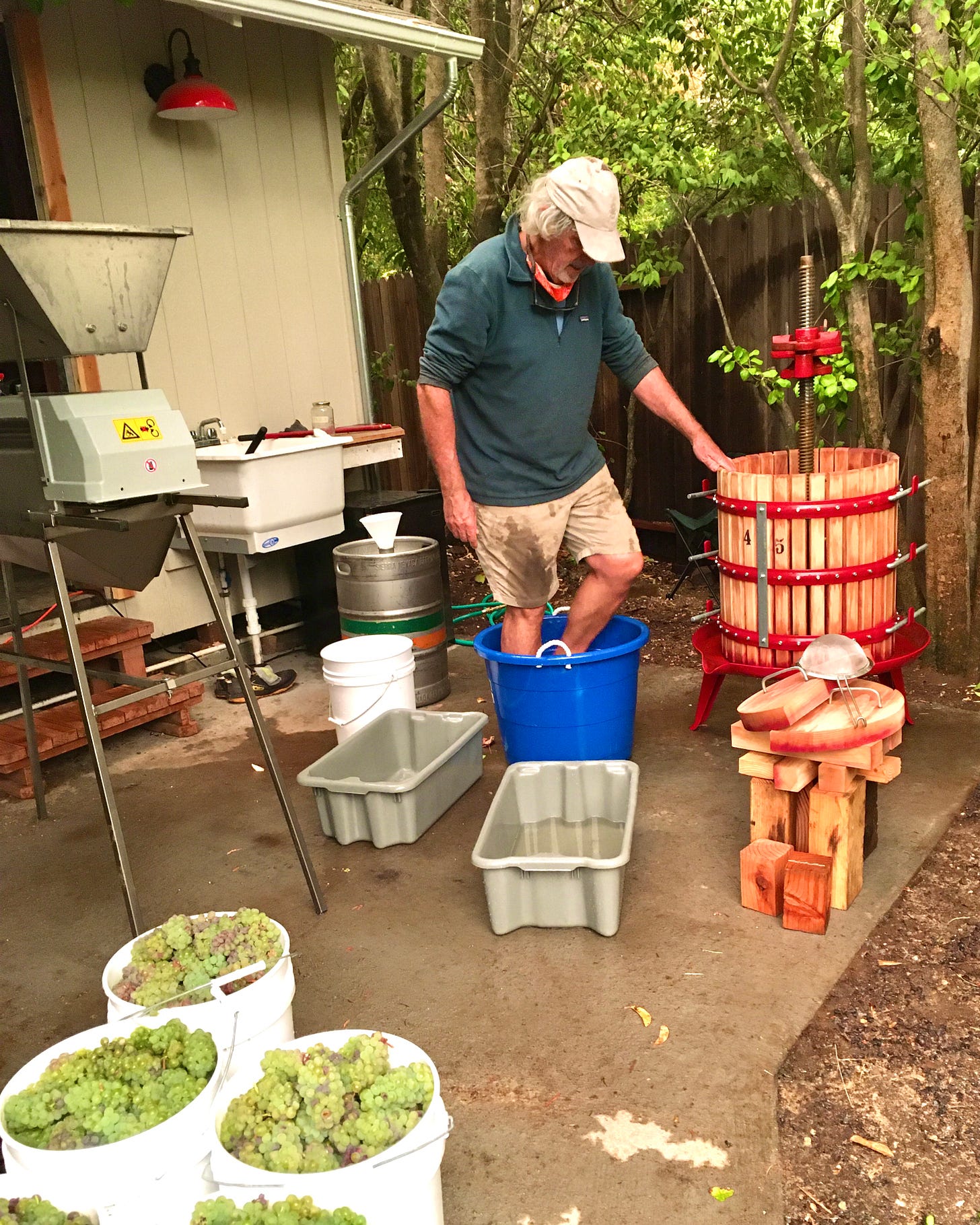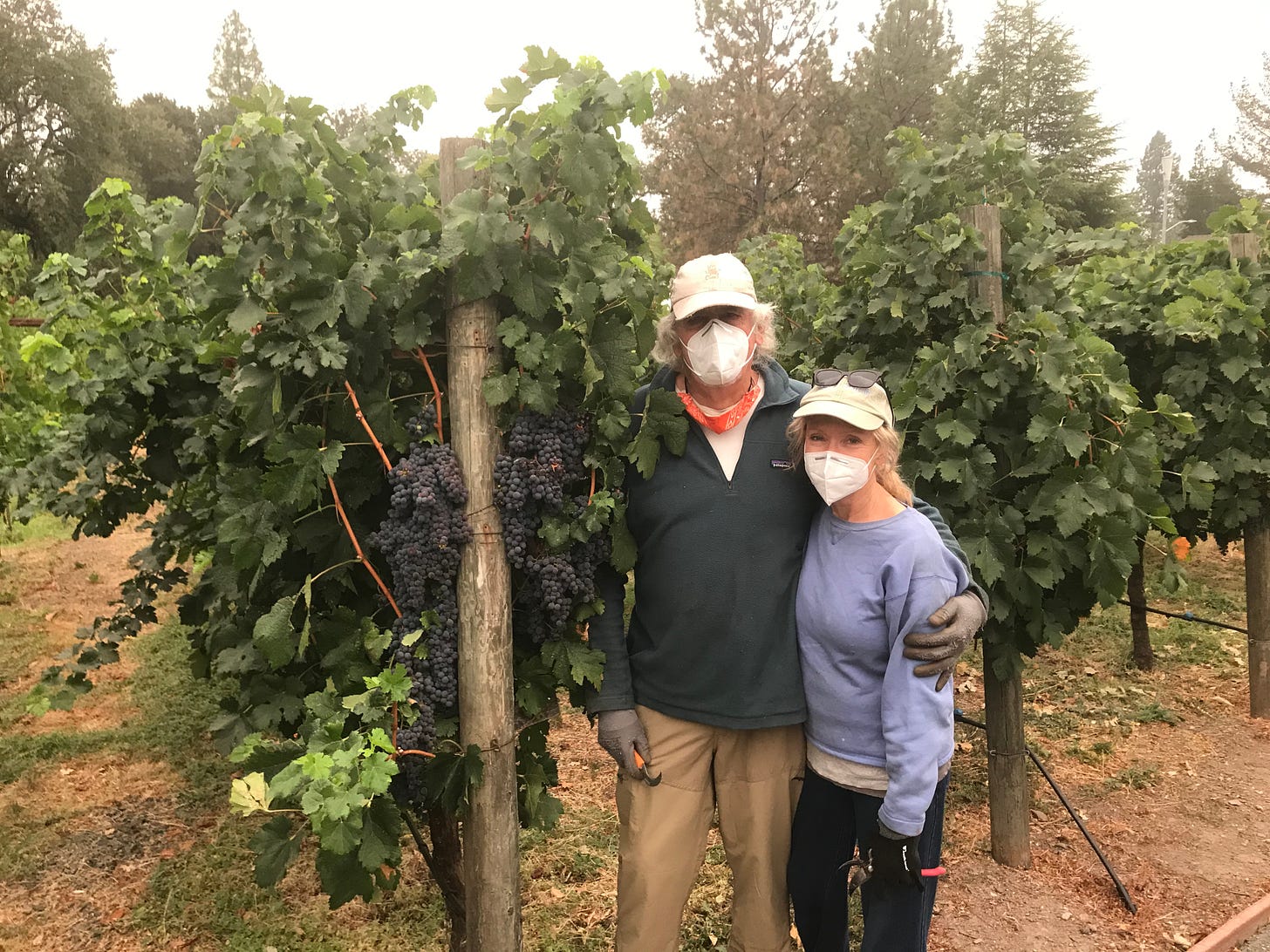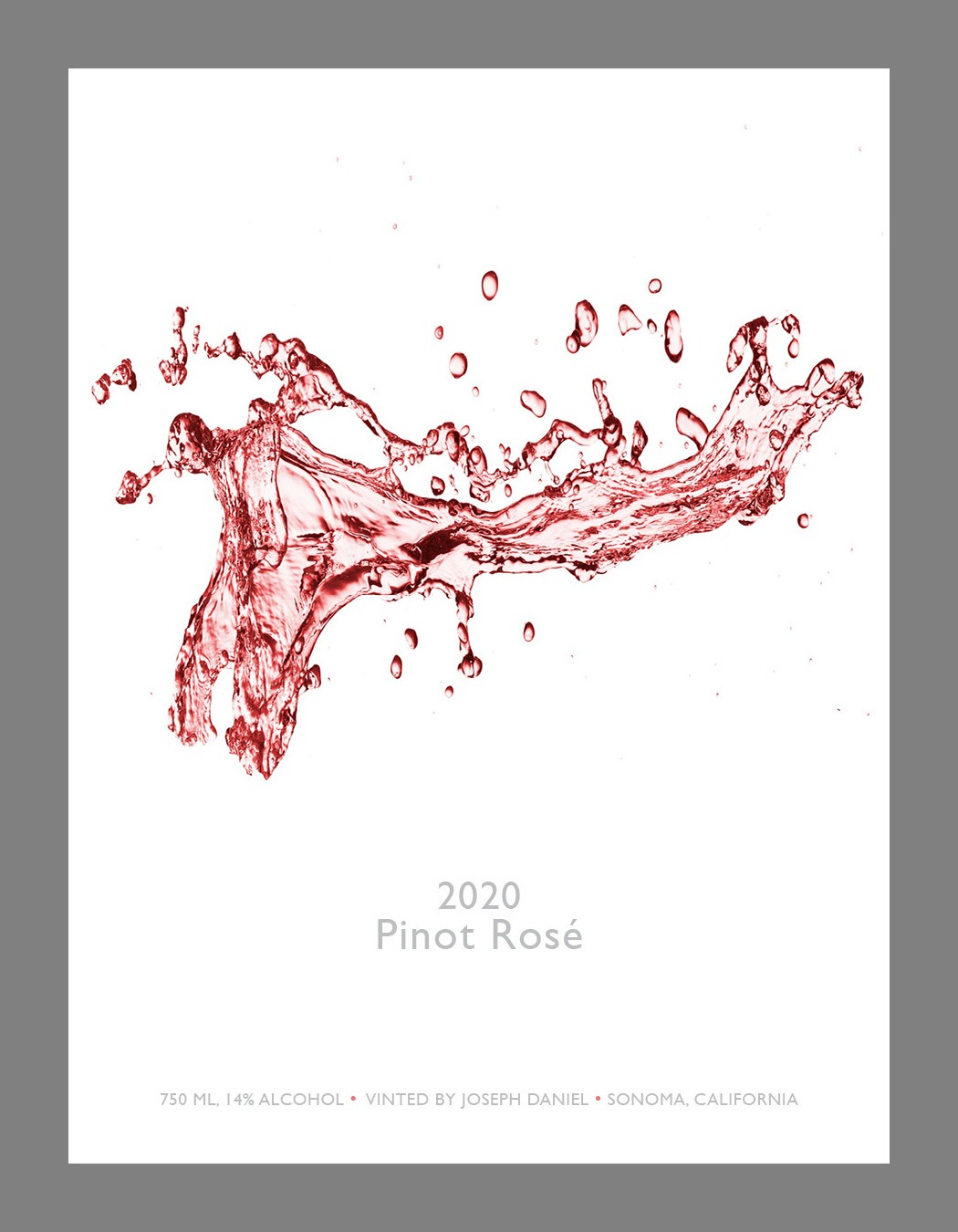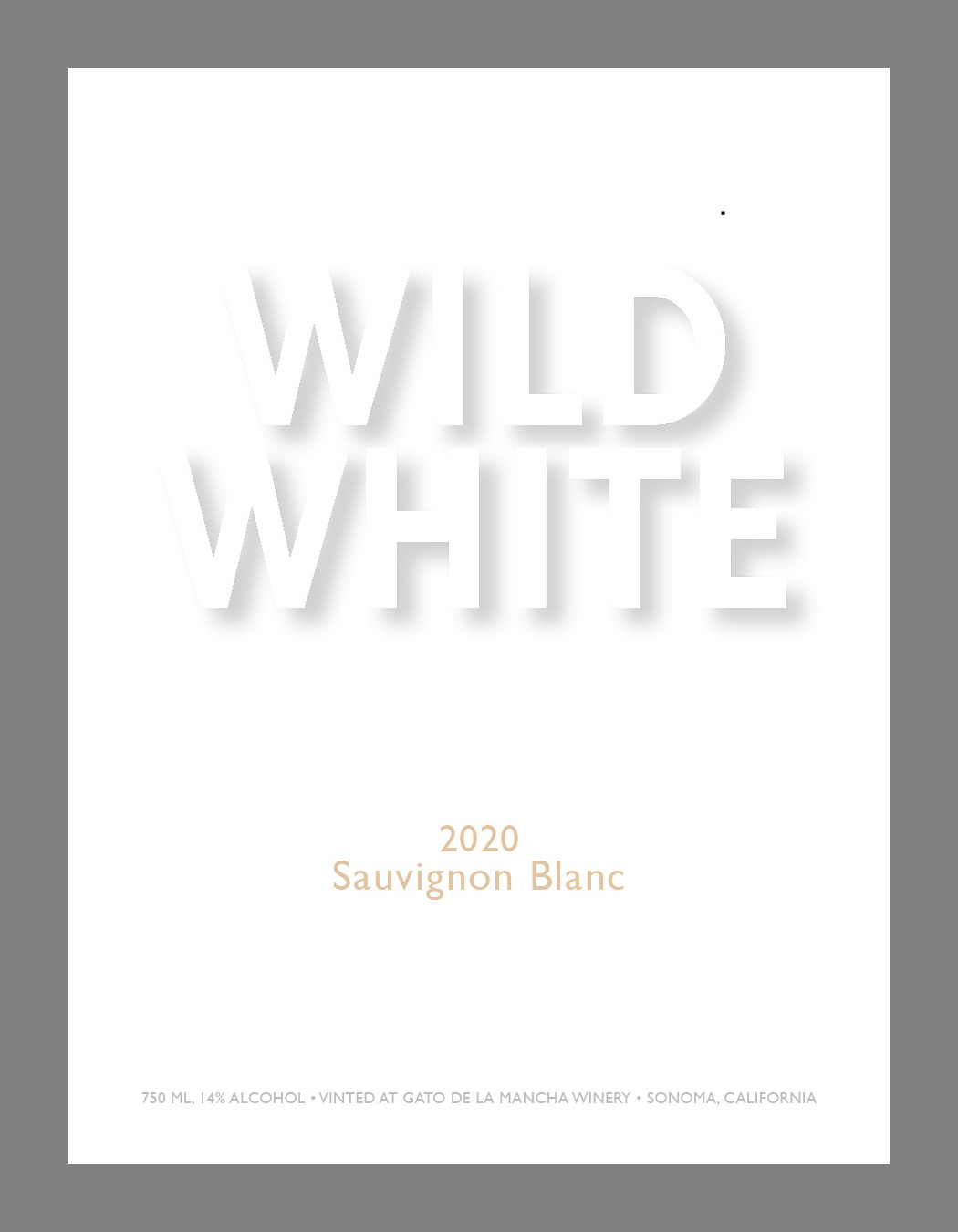Stick your nose in it. Don't be shy, really get your nose in there. A little citrus, maybe some strawberry, passion fruit, and there's the faintest soupçon of like asparagus and just a flutter of a nutty Edam cheese. —Paul Giamatti as Miles Raymond in Sideways (2004)
Jumping ahead (just for now)
I’m taking the liberty here of posting out of order, scribing about wines I made from my third vintage (2020) when I haven’t yet said a word about my second vintage (2019), which was a pivotal coming-of-age year. But these are the first wines I’ve bottled during the short existence of this newsletter, and hey, when a wine you’ve made actually merits, as a friend likes to say, “putting on party clothes and a top hat” (label and capsule) and “taking a limo to the party” (a bottle to your patio), well daddio, you have to make a little noise. If for no other reason than to acknowledge the improbable wonder of it all.
The reason two wines so young are already being bottled is because they are meant to be nouveau—to drink now after just eight months of aging. They won’t last for years in the cellar. They won’t even last past this summer. They’re thought of as door-of-the-fridge, easy-drinking, warm-weather wines—Sauvignon Blanc and Rosé. And damn if I’m going to go against convention.
No-name, big-splash Pinot Rosé — This wine came as an afterthought when my friend Les Bosche and I were partnering up last year to make a 60-gallon barrel of Pinot Noir. I had been reading everything I could find about making high-quality Pinot because we had this amazing, once-in-a-lifetime opportunity to pick as much as we wanted (for free!) from a premium vineyard that had recently lost its buyer contract (more on this later). I certainly didn’t want to blow it given the chance to work with some truly quality grapes, and I really wanted to deliver something special to the generous owner whom we had promised a few cases of the finished wine in return for his largesse.
So I settled on a winemaking method known as saignée. A French term meaning "bleeding," saignée refers to the process of bleeding off juice from a red wine crush in order to increase the skin to juice ratio during the main fermentation. This greater concentration increases the flavors and color of the remaining juice in much the same way you might intensify a sauce by cooking it down. Apparently a lot of premium Pinot Noir vinters swear by saignée as a way to give the normally light-bodied wine a flavor and color boost.
So what happens to the juice that was bled off? Some winemakers simply discard it, others use it for topping off the ullage, or headspace, that occurs at the top of a wine barrel due to evaporation, while those in the know turn it into Rosé. Desperate, as always, to be in the know—that’s what I did with ours.
With a serious heat wave forecast for the next few days, the Brix coming into target range at 23.5°B, and the pH on the rise at 3.6, we decided to do our big Pinot pick on September 5, 2020. Les and his wife, Jill, and Deb and I started picking about 8:30 a.m. and finished four hours later with 1,228 pounds of grapes stuffed into 45 five-gallon buckets in the back of both Les’s and my cars. It was 90° by the time we got back to my winery so we kept the grapes in our cars with the air conditioners on until we were ready to crush.
We initially filled two 55-gallon Brutes (new plastic trash cans) with 45 gallons each of must (crushed grapes, juice, skin, etc.) and then immediately bled off six and a half gallons of pure juice from each one by pouring the must through a strainer. This went into a 15.5-gallon beer keg to become our Rosé, while we continued crushing the rest of the grapes. By the time we finished everything the temperature in the shade was 100°.
From here the story diverges, as we’re now talking about two different wines—the Pinot Noir proper and the Pinot Rosé. I’ll save the story about the Pinot Noir for a later post.
As for the Pinot Rosé, it was to become a contest of us against the heat. Rosé is made just like white wine, requiring much cooler temperatures for fermentation and barreling than red wine. So right after bleeding the juice into the beer keg I inoculated it with Lalvin 71B yeast and then put three frozen water bottles on top of the keg and wrapped it in an old sleeping bag for insulation. That night the temperature inside the winery got down to 66 degrees, which helped some in cooling things off.
By the next morning (Sept. 6) the Rosé fermentation was well underway and I worried that the two and a half gallons of headspace I had left in the keg was going to be enough, as bubbles were already forcing their way up through the bung hole. I changed the now melted water bottles for freshly frozen ones and added another layer of insulation using the cushion of an old chaise lounge. The heat spiked that day to 111°!
By the time I arrived the following morning (Sept. 7) the temperature inside the winery was warmer than the outside temperature. This was due primarily to the heat being given off by the small, very over-worked freezer I was using to freeze water bottles. The Rosé fermentation in the beer keg had gone nuts due to the heat and overflowed into a big brown frothy mess all over the floor. The Brix reading was down to 12°B—nearly halfway through fermentation in two days! Definitely not good for a white wine. I changed the water bottles and moved the freezer outside. It got to 111° again that day. The winery was still at 90°at 7:00 p.m.
The next day (Sept. 8) there was high, heavy smoke in the sky from the fires up north, but the temperature was much cooler—66° at 8:30 a.m. But it eventually got to 98° that afternoon and the Rosé fermentation continued to steamroll ahead. The temperature of the juice was 76° and the Brix reading had fallen to 9°B. Still way too hot and going way too fast.
So I drove over to a farm and feed supply store just outside of town and talked them into letting me buy two empty plastic barrels used for shipping horse-food pellets. I cut these in half with a Skilsaw and filled one with about a foot of cool water. I then partially submerged the beer keg (with the Rosé), which had a much smaller diameter than the horse-pellet-barrel, and dropped four frozen water bottles directly into the water around the keg. I put three more bottles on top of the keg and wrapped the whole thing in an old sleeping bag to insulate.
The best way to describe the next day (Sept. 9) is simply to quote directly from my wine journal, “Crazy-ass day! Woke up to near darkness even though it was 6:30 a.m. The sky barely lightened over the next couple of hours and everything was bathed in a deep orange glow like being inside of a dark, hollowed-out pumpkin. Smoke from all the fires in Northern California, Oregon and Washington was suddenly blowing our way and covering everything west of the Sierra. Never saw the sun all day and it was dark as twilight at 2:00 in the afternoon. Apocalyptic actually.”
As strange and unsettling as that day was, there was some good news. My horse-pellet-barrel submerging technique worked, and by simply changing out the frozen water bottles each day I could keep the temperature of my Rosé fermentation down in the low 60s. Where it had taken only three days to drop Brix from 23.5°B to 9°B, it took seven more days to bring it down to a fully dry state at -.5°B. All was not lost!
On September 14 I racked the Rosé into a 6-gallon glass carboy and a 5-gallon glass carboy, which should have been the end of most of the heavy work. From here on out for the next half a year it would just be a matter of keeping the carboys cool and dark, and maybe racking them one or two more times. But as I went to pick up the 5-gallon carboy to tuck it out of the way, the bottom inexplicably blew out in an explosion of glass, releasing a cascade of pretty pink wine over EVERYTHING in the winery! I was speechless, and then not so much.
It was the end of the day and I was exhausted from another harvest, and now I had to clean this up—and quickly, before it started to dry into a sticky mess. I literally had to sweep a half-inch of wine from the entire floor, out the door, while moving other full barrels of wine around, then go back over it all with a wet mop multiple times. I ended up moving just about everything out of the winery to dry outside overnight, and then went home to a strong tequila.
I didn’t realize it at the time, but I’m certain that event provided unconscious inspiration for the label I designed for the Pinot Rosé. It’s a simple vertical white rectangle framing one of the wonderful wine-splash images of Czech photographer Jakub Gojda, which I bought rights for from dreamstime.com. The bottle is topped with a matching wine-colored capsule.
On a slow, jazzy day late last month Deb and I eventually bottled the Pinot Rosé and the Sauvignon Blanc (see video above). We ended up with just 25 bottles of the Rosé due to the lost carboy, but it is a beautiful pale pink perfectly clarified wine with a classic varietal taste of light red fruits and a soupçon of watermelon. Thanks Paul! I added a small amount of tartaric acid to brighten it up as I think the higher pH and the intense heat from those days-of-fire had some impact. In response, it needs to be served very cold.
Wild White Sauvignon Blanc — One of the first harvest scenes I shot for Tiny Vineyards was Sal Troia and Sherman Patterson crushing a barrel’s worth of Sauvignon Blanc grapes and immediately pressing them on Sal’s old 1869 Buckeye apple press. I didn’t know either of these guys very well yet and their trash talk at each other was a bit disconcerting. I had been told that Sal could be a little gruff at times and I was careful not to get in the way. But it wasn’t long before I realized all the carping was just part of the ritual of winemaking for these two, and they were both at their happiest when chewing the other guy out for some real or imagined mistake.
They couldn’t have been nicer with me and in the end (see video below) Sal even offered me a glass of his precious nectar. “The best grape juice you ever drank!”
That taste of amazing grape juice became a taste of amazing wine a year later, and a year after that I wanted to try making some myself. I didn’t know much about white wine making but I was sure Sal would keep me on track, and I was hoping he would also somehow hook me up with some grapes. I dropped a few hints for a while last August but Sal wasn’t taking the bait. He was, however, continuing to talk about how he might try and pick some Sauvignon Blanc grapes that year from his friend Brian’s vineyard. The only issue was that the vineyard bordered a tall stand of eucalyptus trees and the Merlot that also grew there had a strong menthol taint that showed up in the wine. No one knew for sure if the Sauvignon Blanc would be the same. Finally I just out-and-out asked him.
“Have you decided if you’re going to pick that Sauvignon Blanc?”
“Yep”
“Yep you’ve decided, or yep you’re going to pick it?”
“Gonna pick it.”
“Do you know when?”
“Real soon.”
Quite the conversationalist, this guy. But I pressed on.
“Can I come along, and maybe pick enough to make five or ten gallons for myself? I’ve never made white wine and this would be a great opportunity.”
Silence.
A day later I got a phone message from Sal, “Meet me at my house tomorrow morning at 7:45 a.m. Doug and Sherman and me, and maybe Tom, are going to pick enough Sauvignon Blanc to make a barrel. If you help with the pick, and there’s still enough grapes left, you can have some for yourself.”
And so, a deal was struck. I ended up with about 180 pounds of grapes, just enough to make two 5-gallon glass carboys of wine. This was also the same day (Sept. 9) that Sonoma glowed orange from all the fires and my Sauvignon Blanc would be subject to the same challenges as the Pinot Rosé, plus a couple more that we hadn’t anticipated.
Seems that all the fire danger had played havoc with the town’s electrical grid and sometime during the previous night the GFCI breaker in my little winery had popped. With no power we couldn’t run the crusher. Since the winery was brand new no one knew where that breaker might be (turns out later it was hiding just behind some wine cases), but the grapes were picked and they were quickly warming up. They needed to be crushed and pressed immediately—and so there I was, back in barefoot mode doing things the old-fashioned way.

The fact is that crushing grapes with your feet actually works pretty well, which is why it’s still done in a few of the older winemaking regions. With white wines like Sauvignon Blanc you go right from the crusher to the press, and then into a fermenter all within hours. The idea is to get the juice off the skins (where all the color is) as soon as possible. Then you’re fermenting just juice—no grapes, skins, seeds or stems.
I rigged up another horse-pellet-barrel ice-water bath for the beer keg that was holding the Sauvignon Blanc and was able to keep the temperature down pretty much from the get-go. I decided to let it settle out a bit before inoculating it with yeast as the grapes had been covered with quite a bit of ash from the fires. So I gave it a light dose of potassium metabisulfite to protect from oxidation and hinder any wild yeast from going active. A lot of what looked like ash settled out the first night into the lees, which had changed to a grey color. Worried that there might be some danger of smoke taint, I racked the wine fairly generously from 12 gallons down to 10 gallons to make sure I got rid of any junk.
The next day I inoculated the Sauvignon Blanc with VL3 yeast, and then Deb and I headed over to help Les and Jill harvest their Diana Vineyard of Merlot. We all wore masks throughout that day, as much for the smoke as for the risk of COVID-19. You can see in the photo below how thick the smoke still was in the air and it gave us real concern, both for the quality of the grapes and for our own respiratory health. The world wasn’t a very friendly place just then.

It took several more days for my Sauvignon Blanc must to begin fermenting. I actually had to warm it up a little to get it started. But eventually it began a wonderful, long, slow fermentation from a perfect pH of 3.3 and a rather high Brix of 26°B all the way down to -1°B over a 17-day period, never balking. That was incredible, and the wine developed an aroma that was powerful and exotic—think pear, melon, grapefruit and pineapple. And it was the best-tasting wine I had made to date.
I never got it to fully clarify; there still remains just the faintest haze. But that is okay with me. I didn’t dare filter or even fine it as I didn’t want to take away any of its amazing flavor. And besides, this is a truly natural wine. I did a small bottling of about a dozen bottles early on to solicit opinions from a few palates I trust, and based on that feedback I added a small amount of tartaric acid and stirred it up with what was left of the lees for the final couple of months of aging.
I christened the wine Wild White as a further bastardization of “Savage White,” a rough translation from French of Sauvignon Blanc. And I gave it a white-on-white design theme, with grey drop shadows (ashes?) and a tiny kiss of the wine’s color in its vintage type. I’ve topped the bottle with both a silver capsule and a white one, and they both work well—as does no capsule at all. These party clothes, and the ones for the Pinot Rosé, contrast and compliment the color of the wines.
We ended up with only about 35 bottles from the final bottling and I’m clinging to them like the liquid gold they are. Both this Sauvignon Blanc and the Pinot Rosé were wines that came alive despite themselves, or more accurately, despite me and the events of last fall.
I came away from it all realizing just how much winemaking, especially in small lots at the amateur level, is a very fluid, ever-evolving, ever-threatened venture. You need to be light on your feet and innovative in your thinking. And you need to acknowledge and respect the living nature of the wine. It is pre-ordained to continuously change and develop. Nothing is ruined until it’s ruined, but nothing is finished… ever. Wine is an expression of the winemaker from whom it spawned and if that winemaker can learn to let the wine take charge, at least some of the time, then magic happens.







There is no way to describe the feeling when a 5-gallon carboy ruptures and 50% of your blood, sweat and tears of an entire vintage cascades across your wine cellar floor. Mine was a Cab, which took hours to clean up. The worst part....the faint scarlet stains as a permanent reminder of your blunder. ☹️